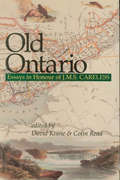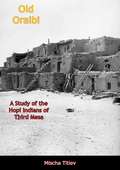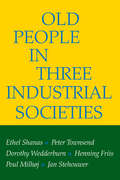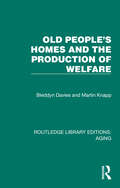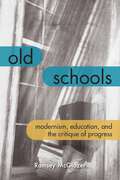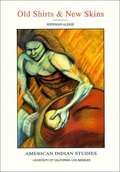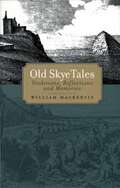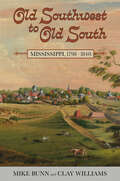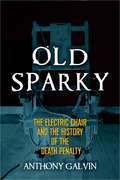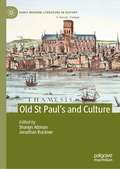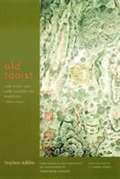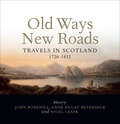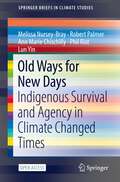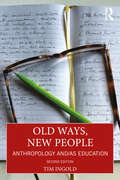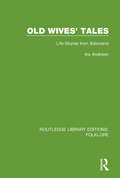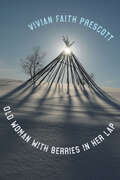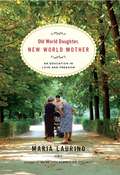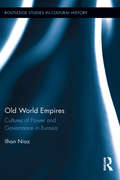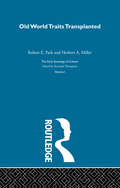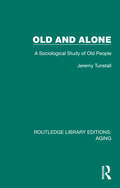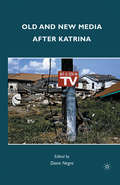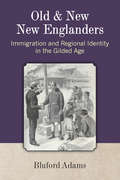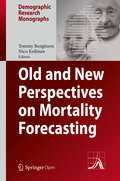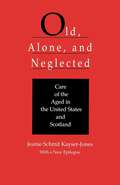- Table View
- List View
Old Ontario: Essays in Honour of J M S Careless
by David KeaneIn ten original studies, former students and colleagues of Maurice Careless, one of Canada’s most distinguished historians, explore both traditional and hitherto neglected topics in the development of nineteenth-century Ontario. Their papers incorporate the three themes that characterize their mentor’s scholarly efforts: metropolitan-hinterland relations; urban development; and the impact of ’limited identities’ — gender, class, ethnicity and regionalism — that shaped the lives of Old Ontarians. Traditional topics — colonial-imperial tension and the growth of Canadian autonomy in the Union period, the making of a ’compact’ in early York, politics in pre-Rebellion Toronto, and the social vision of the late Upper Canadian elites — are re-examined with fresh sensitivity and new sources. Maters about which little has been written — urban perspectives on rural and Northern Ontario, Protestant revivals, an Ontario style in church architecture, the late-nineteenth-century ready-made clothing industry, Native-Newcomer conflict to the 1860s, and the separate and unequal experiences of women and men student teachers at the Provincial Normal school — receive equally insightful treatment. An appreciative biography of Careless, an analysis of the relativism underpinning his approach to national and Ontario history, and a listing of Careless’s publications, complete this stimulating collection.
Old Oraibi: A Study of the Hopi Indians of Third Mesa
by Mischa TitievIn this classic work, renowned anthropologist Mischa Titiev presents his research on the Hopi Native-Americans. Based on fieldwork he did in period 1932 -1940, he describes many aspects of the Hopi culture, from land use and kinship to ceremonies and games. IllustratedTHE HOPI Indians, a tribe speaking a Shoshonean language, are located in the Little Colorado drainage, about 70 miles north of Winslow, Arizona. They are the westernmost representatives of the Pueblo pattern of culture, and archaeological evidence has indicated that they are probably the direct descendants of some of the earliest tribes which settled in the Southwest. Owing in part to geographical isolation, and in part to their stubborn resistance to outside influences, the Hopi have managed to preserve so great a part of their aboriginal culture that they afford a particularly attractive subject for ethnological investigation.
Old People in Three Industrial Societies (Growing Old Ser.)
by Peter Townsend Ethel Shanas Dorothy Wedderburn Henning Kristian Friis Poul Milhoj Jan StehouwerRobert and Helen Lynd's Middletown set the format in sociological theory and practice for hundreds of studies in the decades following its publication in 1929. Old People in Three Industrial Societies may well set similar standards for studies in its fi eld for many years to come. In addition to achieving a signifi cant breakthrough in the progress of socio logical research techniques, the book offers a monumental cross-cultural exposition of the health, family relationships, and social and economic status of the aged in three countries-the United States, Britain, and Denmark.
Old People's Homes and the Production of Welfare (Routledge Library Editions: Aging)
by Bleddyn Davies Martin KnappIn 1980 old people comprised over half the clients of Local Authority Social Services Departments and accounted for about half of their resources, yet until then residential care of the aged had been a backwater of both research and practice. During the 1970s a large research literature had developed on the subject, particularly in the United States. However, studies had been partial in their focus on issues, making no attempt to draw together their arguments to create a model that described and evaluated competing theories about what it is that determines the quality of residential life. Originally published in 1981, Bleddyn Davies and Martin Knapp filled that gap in this book.The authors discuss not only the theoretical arguments about residential care and the degree to which those theories had been verified by research, but also how far the factors considered to be important had been successfully measured, considering the choices to be made between alternative varieties of care that had grown up so rapidly in the previous five years. The authors conclude with an analysis of how their approach should contribute to the discussion of issues that was to be faced by British policy-makers in the 1980s as our welfare systems attempted to cope with the increasing numbers of the very old.
Old Schools: Modernism, Education, and the Critique of Progress (Lit Z)
by Ramsey McGlazerWinner: AAIS First Book PrizeOld Schools marks out a modernist countertradition. The book makes sense of an apparent anachronism in twentieth-century literature and cinema: a fascination with outmoded, paradigmatically pre-modern educational forms that persists long after they are displaced in progressive pedagogical theories.Advocates of progressive education turned against Latin in particular. The dead language—taught through time-tested means including memorization, recitation, copying out, and other forms of repetition and recall—needed to be updated or eliminated, reformers argued, so that students could breathe free and become modern, achieving a break with convention and constraint. Yet McGlazer’s remarkable book reminds us that progressive education was championed not only by political progressives, but also by Fascists in Italy, where it was an object of Gramsci’s critique. Building on Gramsci’s pages on the Latin class, McGlazer shows how figures in various cultural vanguards, from Victorian Britain to 1970s Brazil, returned to and reimagined the old school.Strikingly, the works that McGlazer considers valorize this school’s outmoded techniques even at their most cumbersome and conventional. Like the Latin class to which they return, these works produce constraints that feel limiting but that, by virtue of that limitation, invite valuable resistance. As they turn grammar drills into verse and repetitious lectures into voiceovers, they find unlikely resources for critique in the very practices that progressive reformers sought to clear away.Registering the past’s persistence even while they respond to the mounting pressures of modernization, writers and filmmakers from Pater to Joyce to Pasolini retain what might look like retrograde attachments—to tradition, transmission, scholastic rites, and repetitive forms. But the counter-progressive pedagogies that they devise repeat the past to increasingly radical effect. Old Schools teaches us that this kind of repetition can enable the change that it might seem to impede.
Old Shirts and New Skins
by Sherman AlexieSherman Alexie's poetic power renders an honest and painful perception of contemporary Native American life. In this collection, Alexie, a poet of the Coeur d'Alene people, speaks for the spirit of Native American resistance.
Old Skye Tales: Traditions, Reflections and Memories
by William MackenzieAn extraordinary compilation of lore, legend, tradition, and incident from Scotland&’s Isle of Skye. Written by a Glasgow-born Scotsman whose accomplishments ranged from working in the Clydesdale shipyards, serving as a headmaster, fighting for the rights of crofters, serving in the British and Indian armies, and producing acclaimed poetry, this volume is one of the most important sources for the history of the Isle of Skye. As well as containing a large amount of information of the geography of the island—particularly the north—it also contains important sections on crofting and the Church, as well as local superstitions, sayings, second sight, and even local characters of his time.
Old Southwest to Old South: Mississippi, 1798-1840 (Heritage of Mississippi Series)
by Clay Williams Mike BunnMississippi’s foundational epoch—in which the state literally took shape—has for too long remained overlooked and shrouded in misunderstanding. Yet the years between 1798, when the Mississippi Territory was created, and 1840, when the maturing state came into its own as arguably the heart of the antebellum South, was one of remarkable transformation. Beginning as a Native American homeland subject to contested claims by European colonial powers, the state became a thoroughly American entity in the span of little more than a generation. In Old Southwest to Old South: Mississippi, 1798–1840, authors Mike Bunn and Clay Williams tell the story of Mississippi’s founding era in a sweeping narrative that gives these crucial years the attention they deserve.Several key themes, addressing how and why the state developed as it did, rise to the forefront in the book’s pages. These include a veritable list of the major issues in Mississippi history: a sudden influx of American settlers, the harsh saga of Removal, the pivotal role of the institution of slavery, and the consequences of heavy reliance on cotton production. The book bears witness to Mississippi’s birth as the twentieth state in the Union, and it introduces a cast of colorful characters and events that demand further attention from those interested in the state’s past. A story of relevance to all Mississippians, Old Southwest to Old South explains how Mississippi’s early development shaped the state and continues to define it today.
Old Sparky: The Electric Chair and the History of the Death Penalty
by Anthony GalvinIn early 2013, Robert Gleason became the latest victim of the electric chair, a peculiarly American execution method. Shouting Pog mo thin ("Kiss my ass" in Gaelic) he grinned electricity shot through his system. When the current was switched off his body slumped against the leather restraints, and Gleeson, who had strangled two fellow inmates to ensure his execution was not postponed, was dead. The execution had gone flawlessly--not a guaranteed result with the electric chair, which has gone horrifically wrong on many occasions. Old Sparky covers the history of capital punishment in America and the "current wars” between Edison and Westinghouse which led to the development of the electric chair. It examines how the electric chair became the most popular method of execution in America, before being superseded by lethal injection. Famous executions are explored, alongside quirky last meals and poignant last words. The death penalty remains a hot topic of debate in America, and Old Sparky does not shy away from that controversy. Executions have gone spectacularly wrong, with convicts being set alight, and needing up to five jolts of electricity before dying. There have been terrible miscarriages of justice, and the death penalty has not been applied even-handedly. Historically, African-Americans, the mentally challenged, and poor defendants have been likely to get the chair, an anomaly which led the Supreme Court to briefly suspend the death penalty. Since the resumption of capital punishment in 1976 Texas alone has executed more than 500 prisoners, and death row is full. Skyhorse Publishing, as well as our Arcade imprint, are proud to publish a broad range of books for readers interested in history--books about World War II, the Third Reich, Hitler and his henchmen, the JFK assassination, conspiracies, the American Civil War, the American Revolution, gladiators, Vikings, ancient Rome, medieval times, the old West, and much more. While not every title we publish becomes a New York Times bestseller or a national bestseller, we are committed to books on subjects that are sometimes overlooked and to authors whose work might not otherwise find a home.
Old St Paul’s and Culture (Early Modern Literature in History)
by Shanyn Altman Jonathan BucknerOld St Paul’s and Culture is an interdisciplinary collection of essays that looks predominantly at the culture of Old St Paul’s and its wider precinct in the early modern period, while also providing important insights into the Cathedral’s medieval institution. The chapters examine the symbolic role of the site in England’s Christian history, the London book trade based in and around St Paul’s, the place of St Paul’s commercial indoor playhouse within the performance culture of sixteenth and seventeenth-century London, and the intersection of religion and politics through events such as civic ceremonies and occasional sermons. Through the organising theme of culture, the authors demonstrate how the site, as well as the people and trades occupying the precinct, can be positioned within wider fields of representations, practices, and social networks. A focus on St Paul’s is therefore about more than just the specific site on Ludgate Hill: it is about those practices and representations connected to it, which either extended beyond or originated in places other than the Cathedral environs. This points to the range of localised, regional, national, and transnational relationships in which the precinct and its people were situated and to which they contributed.
Old Taoist: The Life, Art, And Poetry Of Kodôjin (1865-1944)
by Stephen Addiss J. Thomas Rimer Jonathan ChavesIn the literary and artistic milieu of early modern Japan the Chinese and Japanese arts flourished side by side. Kodojin, the "Old Taoist" (1865-1944), was the last of these great poet-painters in Japan. Under the support of various patrons, he composed a number of Taoist-influenced Chinese and Japanese poems and did lively and delightful ink paintings, continuing the tradition of the poet-sage who devotes himself to study of the ancients, lives quietly and modestly, and creates art primarily for himself and his friends. Portraying this last representative of a tradition of gentle and refined artistry in the midst of a society that valued economic growth and national achievement above all, this beautifully illustrated book brings together 150 of Kodojin's Chinese poems (introduced and translated by Jonathan Chaves), more than 100 of his haiku and tanka (introduced and translated by Stephen Addiss), and many examples of his calligraphy and ink paintings. Addiss's in-depth introduction details the importance of the poet-painter tradition, outlines the life of Kodojin, and offers a critical appraisal of his work, while J. Thomas Rimer's essay puts the literary work of the Old Taoist in context.
Old Ways New Roads: Travels in Scotland, 1720–1832
by John Bonehill, Anne Dulau Beveridge and Nigel LeaskIn 1725 an extensive military road and bridge-building programme was implemented by the British crown that would transform 18th-century Scotland. Aimed at pacifying some of her more inaccessible regions and containing the Jacobite threat, General Wade’s new roads were designed to replace ‘the old ways’ and ‘tedious passages’ through the mountains. Over the next few decades, the laying out of these routes opened up the country to visitors from all backgrounds. After the 1760s, soldiers, surveyors and commercial travellers were joined by leisure tourists and artists, eager to explore Scotland’s antiquities, natural history and scenic landscapes, and to describe their findings in words and images. In this book a number of acclaimed experts explore how the Scottish landscape was variously documented, evaluated, planned and imagined in words and images. As well as a fascinating insight into the experience of travellers and tourists, it also considers how they impacted on the experience of the Scottish people themselves.
Old Ways for New Days: Indigenous Survival and Agency in Climate Changed Times (SpringerBriefs in Climate Studies)
by Robert Palmer Melissa Nursey-Bray Ann Marie Chischilly Phil Rist Lun YinThis Open Access book provides a critical reflection into how indigenous cultures are attempting to adapt to climate change. Through detailed first-hand accounts, the book describes the unique challenges facing indigenous peoples in the context of climate change adaptation, governance, communication strategies, and institutional pressures. The book shows how current climate change terminologies and communication strategies often perpetuate the marginalisation of indigenous peoples and suggests that new approaches that prioritise Indigenous voices, agency and survival are required. The book first introduces readers to Indigenous peoples and their struggles related to climate change, describing the impacts of climate change on their everyday lives and the adaptation strategies currently undertaken to address them. These strategies are then detailed through case studies which focus on how Indigenous knowledge and practices have been used to respond to and cope with climate change in a variety of environments, including urban settings. The book discusses specific governance challenges facing Indigenous peoples, and presents new methods for engagement that will bridge existing communication gaps to ensure Indigenous peoples are central to the implementation of climate change adaptation measures. This book is intended for an audience of Indigenous peoples, adaptation practitioners, academics, students, policy makers and government workers.
Old Ways, New People: Anthropology and/as Education
by Tim IngoldIn this second and retitled edition of Anthropology and/as Education, Tim Ingold shows that there is more to anthropology than ethnography and more to education than teaching and learning. Building on the first edition’s exploration of the interface between the disciplines of anthropology and education, this revised edition pushes the bounds further, calling upon anthropologists to rethink their disciplinary vocation, by regarding it as fundamentally an educational rather than an ethnographic endeavour.What does a reimagining of anthropology mean for the ways we think about study and the school, teaching and learning, and the freedoms they exemplify? And how does it bear on the practices of participation and observation, on ways of study in the field and in the school, on art and science, research and teaching? This edition has been revised and expanded throughout and includes a major new chapter on how the educational mission of anthropology can shape the university of the future. This book will appeal to all who are seeking alternatives to mainstream agendas in social and educational policy, including educators and students in philosophy, the social sciences, educational psychology, environmentalism and arts practice.
Old Wives' Tales Pbdirect: Life-stories from Ibibioland (Routledge Library Editions: Folklore Ser.)
by Iris AndreskiThis volume is a collection of tales of life histories of 26 elderly women from Ibiboland. It obtains a first-hand record of the pattern of life and banishes the myth of primitivity of the African by illustrating the complexity of conversational language of peasants and market women.
Old Woman with Berries in Her Lap (The Alaska Literary Series)
by Vivian Faith PrescottThrough a single descendant’s voice that speaks to the Sámi diaspora, this collection of poems is a journey through colonialism, transgenerational trauma, and identity. Many have heard of the Sámi reindeer herders brought to Alaska by Sheldon Jackson in the 1800s, but not much is known about the Sámi diaspora experiences in the state and beyond. The poems in Old Woman with Berries in Her Lap use the North Sámi language as well as graphics and various types of poetry to tell these stories of migration and diaspora. Vivian Faith Prescott’s use of language is both a celebration of the richness of the Sámi languages and a mourning of the loss of language that occurs when a population is displaced and forced to exist in a totally foreign language space. According to Sámilinguist, professor, and politician Ole Henrik Magga, the Sámi languages have “very easily . . . one thousand lexemes with connections to snow, ice, freezing, and melting.” These lexemes frame many of Prescott’s poems, introducing ideas and feelings around the loss of language and culture. A compelling insight into the Sámi culture from a contemporary poet’s eye, Old Woman with Berries in Her Lap juxtaposes past and present in an act of reclamation.
Old World Daughter, New World Mother: An Education in Love and Freedom
by Maria LaurinoIn an attempt to discuss feminism through the prism of ethnic identity, the author of "Were You Always an Italian?" brews an unusual and affirming blend of contemporary and traditional values, in this warm, smart, and witty personal investigation of ethnicity and womanhood.
Old World Empires: Cultures of Power and Governance in Eurasia (Routledge Studies in Cultural History #25)
by Ilhan NiazThis book is a sweeping historical survey of the origins, development and nature of state power. It demonstrates that Eurasia is home to a dominant tradition of arbitrary rule mediated through military, civil and ecclesiastical servants and a marginal tradition of representative and responsible government through autonomous institutions. The former tradition finds expression in hierarchically organized and ideologically legitimated continental bureaucratic states while the latter manifests itself in the state of laws. In recent times, the marginal tradition has gained in popularity and has led to continental bureaucratic states attempting to introduce democratic and constitutional reforms. These attempts have rarely altered the actual manner in which power is exercised by the state and its elites given the deeper and historically rooted experience of arbitrary rule. Far from being remote, the arbitrary culture of power that emerged in many parts of the world continues to shape the fortunes of states. To ignore this culture of power and the historical circumstances that have shaped it comes at a high price, as indicated by the ongoing democratic recession and erosion of liberal norms within states that are democracies.
Old World Traits Transpl:Esc V (The\making Of Sociology Ser.)
by Robert E. Park Herbert A. MillerFirst published in 2003. Routledge is an imprint of Taylor & Francis, an informa company.
Old and Alone: A Sociological Study of Old People (Routledge Library Editions: Aging)
by Jeremy TunstallWhat is it like to be an isolated old widow, living alone on the bare old-age pension? In the 1960s, the question had become a standard refrain. Originally published in 1966, this was the first full-length study by a sociologist of isolation in old age.Although the majority of old people were in no sense a problem group at the time, a substantial minority of the elderly were ‘alone’ in one or more ways. About 1.3 million people aged sixty-five and over in Britain lived alone; a large number admitted to feeling lonely, at least sometime. About a million were actually socially isolated in terms of low level and frequency of social contact. Mr Tunstall also uses a fourth category of aloneness – namely anomie (as developed by Durkheim, Merton, and Srole).This report uses careful and statistical analysis of the four types of aloneness and of specially affected groups such as the single, the recently widowed, and the housebound. But it also includes details of interviews with ten highly individual old people from suburban Harrow, booming Northampton, industrial revolution Oldham, and rural South Norfolk.The book contains a discussion of the problem of personality in isolation, and a commentary on the inadequacies of social theory about old age. Finally, the concluding chapter suggests a wide variety of policy measures which might help to alleviate social isolation in old age.
Old and New
by Tammy Jones Margie Burton Cathy FrenchThis book is about the differences between old items and new items. (Set of 6 with Teacher's Guide and Comprehension Question Card)
Old and New Media after Katrina
by Diane NegraOn the fifth anniversary of Hurricane Katrina, this book examines the television coverage of September, 2005, and the manifestation of its legacy in a range of other media forms.
Old and New New Englanders: Immigration and Regional Identity in the Gilded Age
by Bluford AdamsIn Old and New New Englanders, Bluford Adams provides a reenvisioning of New England's history and regional identity by exploring the ways the arrival of waves of immigrants from Europe and Canada transformed what it meant to be a New Englander during the Gilded Age. Adams's intervention challenges a number of long-standing conceptions of New England, offering a detailed and complex portrayal of the relations between New England's Yankees and immigrants that goes beyond nativism and assimilation. In focusing on immigration in this period, Adams provides a fresh view on New England's regional identity, moving forward from Pilgrims, Puritans, and their descendants and emphasizing the role immigrants played in shaping the region's various meanings. Furthermore, many researchers have overlooked the newcomers' relationship to the regional identities they found here. Adams argues immigrants took their ties to New England seriously. Although they often disagreed about the nature of those ties, many immigrant leaders believed identification with New England would benefit their peoples in their struggles both in the United States and back in their ancestral lands. Drawing on and contributing to work in immigration history, as well as American, gender, ethnic, and New England studies, this book is broadly concerned with the history of identity construction in the United States while its primary focus is the relationship between regional categories of identity and those based on race and ethnicity. With its interdisciplinary methodology, original research, and diverse chapter topics, the book targets both specialist and nonspecialist readers.
Old and New Perspectives on Mortality Forecasting (Demographic Research Monographs)
by Tommy Bengtsson Nico KeilmanThis open access book describes methods of mortality forecasting and discusses possible improvements. It contains a selection of previously unpublished and published papers, which together provide a state-of-the-art overview of statistical approaches as well as behavioural and biological perspectives. The different parts of the book provide discussions of current practice, probabilistic forecasting, the linearity in the increase of life expectancy, causes of death, and the role of cohort factors. The key question in the book is whether it is possible to project future mortality accurately, and if so, what is the best approach. This makes the book a valuable read to demographers, pension planners, actuaries, and all those interested and/or working in modelling and forecasting mortality.
Old, Alone, and Neglected: Care of the Aged in Scotland and the United States (Comparative Studies of Health Systems and Medical Care #4)
by Jeanie Schmit Kayser-JonesAs the median age of the population increases, the care and housing of the elderly in the U.S. are of increasing concern. Jeanie Kayser-Jones compares a typical private institution in the U.S. with a government-owned home in Scotland.Her analysis compels attention to the systematic abuse of the institutionalized elderly in the U.S.
